I decided to write this guide to Puebla food after my second visit to this charming city in Central Mexico. Although you’ll find all your favorite Mexican foods here, the city has distinct specific regional cuisine with several delectable Puebla dishes invented (and best eaten!) here.
Puebla is known for several things, for example being the first well-planned city of Mexico based on a 100-block system; its spectacular cathedral and churches, and defeating the French during the 1862 Battle of Puebla (resulting in the Cinco de Mayo celebrations).
And, although I’m a biased foodie, it’s fair to say Puebla is famous over Mexico for its unique cuisine!
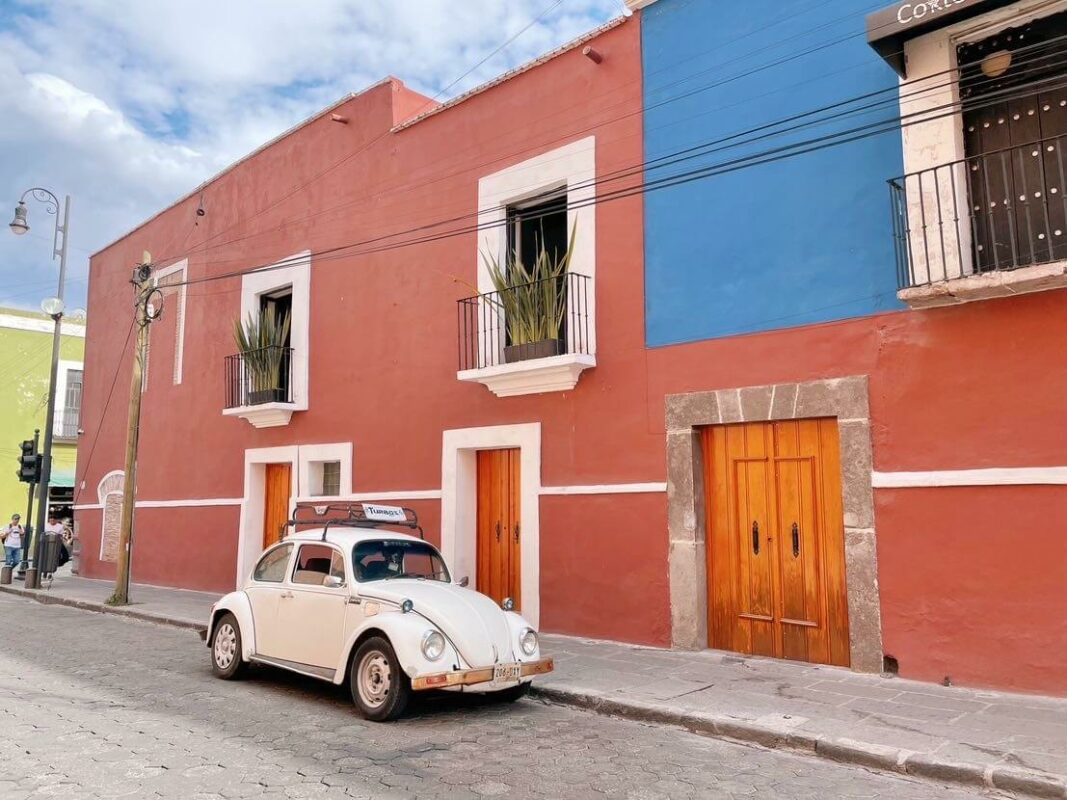
What is the food in Puebla like?
Poblana food is divine! With rich sauces such as mole poblano made with cacao, and thick nogada sauce made with walnut, you can certainly say the Puebla cuisine is muy rico (very rich!).
It’s also the history and geography that makes the food from Puebla special. Nestled between several volcanos, the land in Puebla state is extra fertile and has been producing bounties such as seeds, chilis, and fruits for thousands of years. Combined with influence from Spanish rule and Middle Eastern settlers, it’s a diverse cuisine like no other.
Like this guide to Puebla Mexican food? Pin it for later on Pinterest!
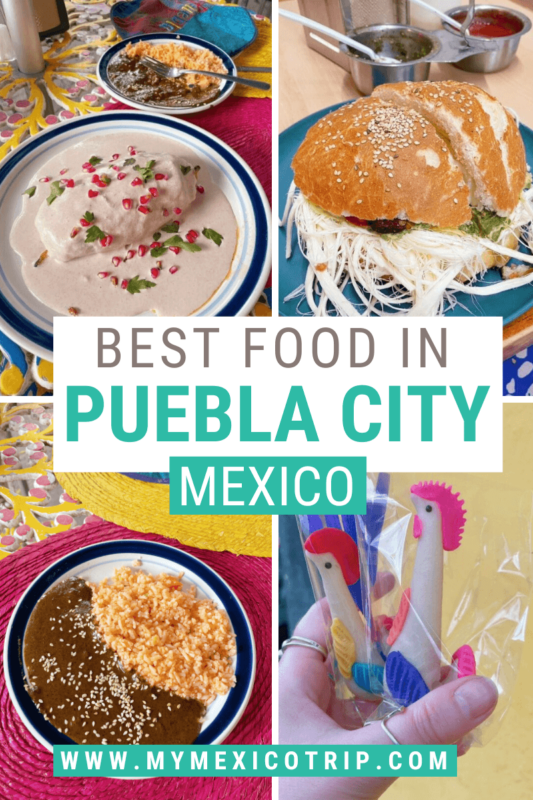
The best food in Puebla, Mexico
These are the top Puebla dishes you must try, many invented here. I’ll share their stories as we go. From street food to restaurant meals, let’s get stuck in. I hope you’re hungry!
If you’re wondering what food is Puebla known for?, here are your answers…
Chile en nogada (chili in walnut)
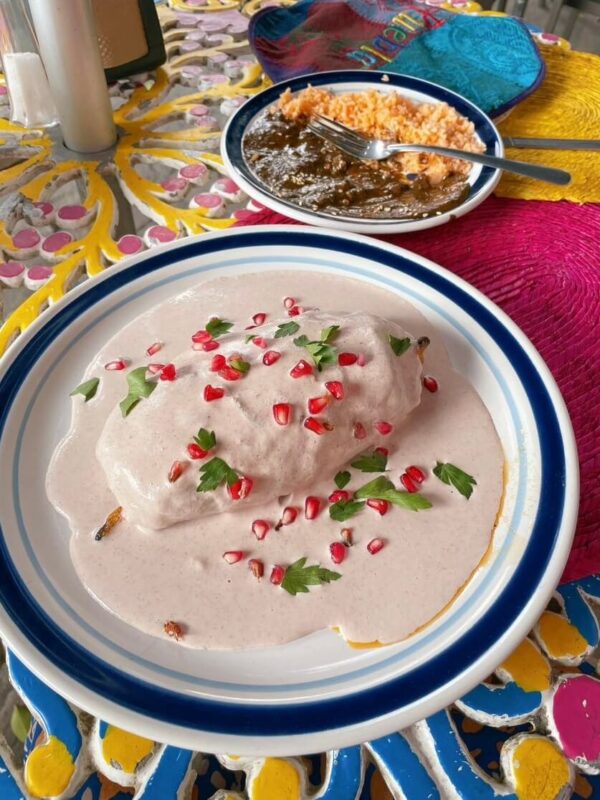
Chili en nogada, translating as chili in walnut, is possibly THE most famous Puebla dish. A giant green chili pepper is stuffed with a mix of ground meat, nuts, apple, peach, and pear. The whole thing is lightly battered then laid to rest in a creamy walnut sauce combing milk, double cream, queso fresco, and sherry (not a health food!) and topped with parsley and red pomegranate seeds.
The sweet and salty mix is unique and delicious!
The legend goes that when emperor, Agustín de Iturbidean, was in town, the nuns of the convent had the chance to make a dish to impress him. They invented chili en nogada to represent the Mexican flag: red pomegranate, green chili peppers and parsley, and white sauce.
Due to the availability of certain ingredients (the pomegranate and peach in particular), chili en nogada season is August-October. In this season, all the restaurants in town serve this beauty. However, it’s not game over if you visit out of season: there will still be a few places serving it, although prices will be slightly higher (around 250 pesos a serving).
One place in Puebla that serves chili en nogada year-round is Fonda Tipicana La Poblana. Not only did they give me some free tortilla chips with mole sauce when I sat down, but the waiter told me that a portion of mole with rice came with my chili en nogada for free. No complaints from me!
Mole poblano
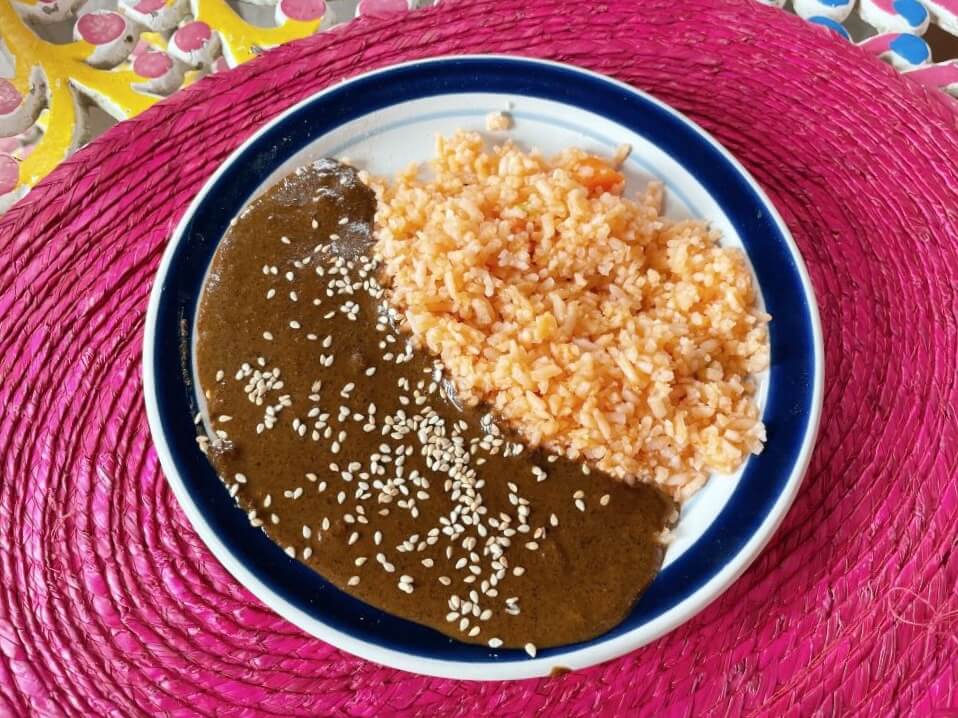
Mole! Where to start with this rich, delicious sauce? When I first arrived in Mexico a few years ago, I exclaimed ‘chocolate sauce!?’ thinking this was the strangest invention ever. But it didn’t take long for me to love it!
Puebla and Oaxaca claim to have invented mole and we’ll probably never know the truth. The Puebla legend (that we’ll run with – this is a Puebla food guide, after all!) says the local convent invented it with ingredients lying around when an important archbishop came to visit. Nowadays, it’s associated with Cinco de Mayo, the day when locals celebrate defeating Napoleon’s Army during the Battle of Puebla in 1862.
One thing we can all agree on: mole comes from the Nahuatl word for sauce, mōlli. You may recognize it from your fave avocado-based dip, guacamole. It picked up popularity after independence in 1821 and now features on the UNESCO list of Intangible Cultural Heritage.
Mole poblano is a complex recipe containing at least 16 ingredients not limited to cacao, chili, almonds, peanuts, sesame seeds, cilantro, garlic, and onion. Best served over rice, enchiladas, or chicken, it can be found in countless Puebla restaurants.
Cemitas
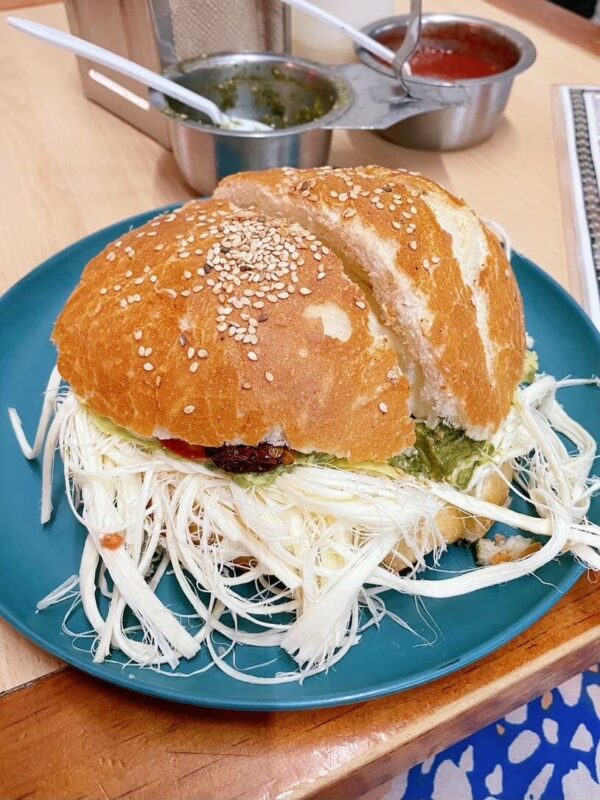
If you’ve never heard of cemitas before but think they look suspiciously like tortas (juicy Mexican sandwiches), you’d be right. But technically, there are a few differences between cemitas and tortas, one being that cemitas are made with a type of bread typical to Puebla.
Another difference is the ingredients used: cemitas from Puebla typically contain quesillo cheese, also sometimes called Oaxaca cheese. However, my tour guide on the free walking tour of Puebla said the local Poblanos don’t like you calling it Oaxaca cheese, I’m guessing because of the foodie rivalry between the two cities.
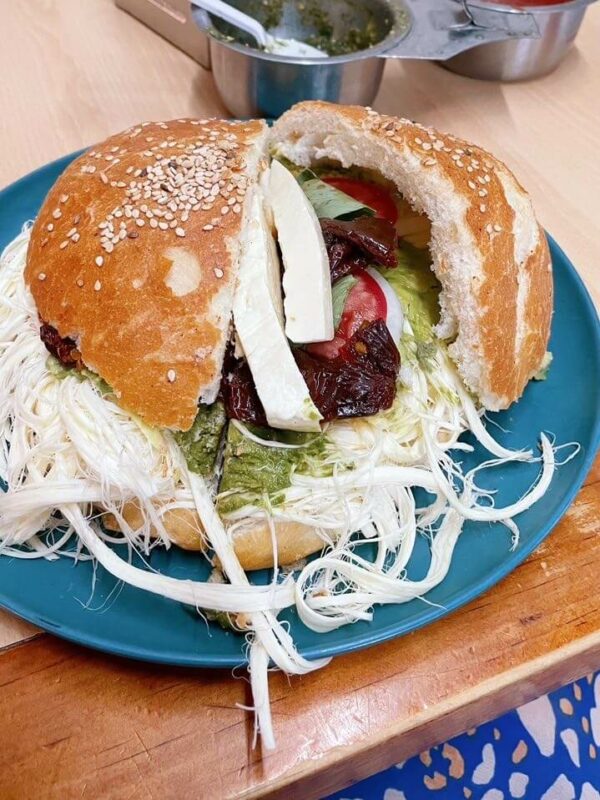
A typical Puebla cemita will include quesillo, avocado, tomato, papalo leaves, and dried chipotle peppers at a minimum. You can also add different types of meat for example ham and/or milanesa (a fried meat cutlet, usually chicken or pork).
Unless you’re a huge meat lover, I don’t think you need to add meat because a cemita is already HUGE. They’re a good Puebla food for veggies visiting the city. Even a vegan version with avocado, salad, and chipotles would be great!
Where to find the best cemitas in Puebla
- Cemitas y Tortas La Poblanita – for a restaurant in the city center with fantastic reviews and a huge range of Pueblan sandwiches, you can’t beat this spot.
- Antojitos Tomy – this modest local restaurant near my hostel was a great find. They serve amazing cemitas as well as all the other top Puebla dishes like molotes.
Variations on the cemita
If you’re an absolute eating MACHINE and have demolished a cemita (marry me!), there are a couple of other sandwich variations eaten in Puebla. One is a chancla, fried in a red sauce made from tomato and chili sauce similar to the ahogada (drowned torta) from Guadalajara. Typical ingredients include chorizo, beef, and avocado.
Another type of Puebla sandwich is the pelona where the bread is fried in lard for its signature crunch and stuffed with shredded meat, frijoles, lettuce, and cream. It translates as ‘bald woman’ apparently because of the way it looks… I’m not convinced!
Pipian – rojo and verde
Pipian is one of the oldest Pueblan foods, enjoyed way back in the Aztec era. This sauce is primarily made from pumpkin seed, unlike moles which are more commonly made with nuts. Other ingredients in a popular pipian include cumin, coriander, and garlic.
You can get pipian rojo (red) made with red Poblano chilis and tomatoes, and pipian verde (green) made with green chili peppers such as serrano. Pipian can be served over anything from enchiladas to the next Puebla dish I’ll mention…
Chalupas
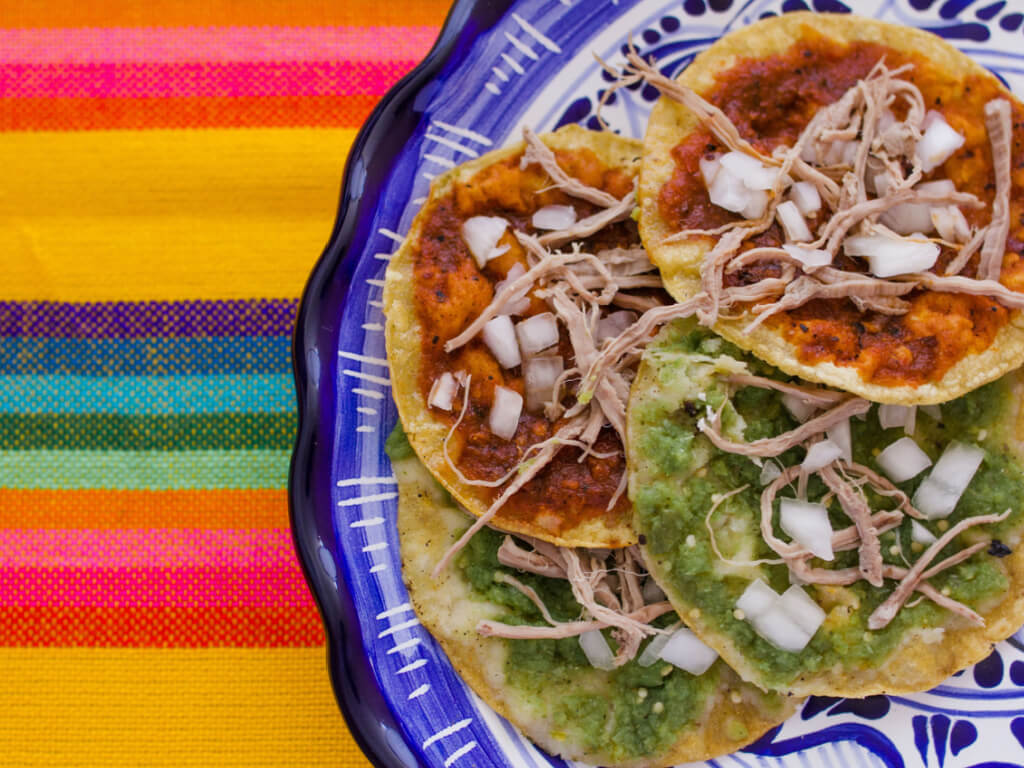
These thin and crispy patties are a popular Mexican food from Puebla. Made from the same base ingredient (corn dough AKA masa de maiz) as tacos, sopes, gorditas, and all your other Mexican faves, these tasty little morsels can be found in restaurants and as street food in Puebla.
Shaped slightly like a boat or cup, chalupas are lightly fried and topped with ingredients of choice such as meat, potatoes, cheese, and either salsa rojo or verde (red or green sauce). It’s thought they’ve been served since pre-colonial times.
You can rarely order one chalupa (and frankly, why would you want to?); they usually come in a serving of five. There are many places to eat chapulas in Puebla.
Tacos Arabes
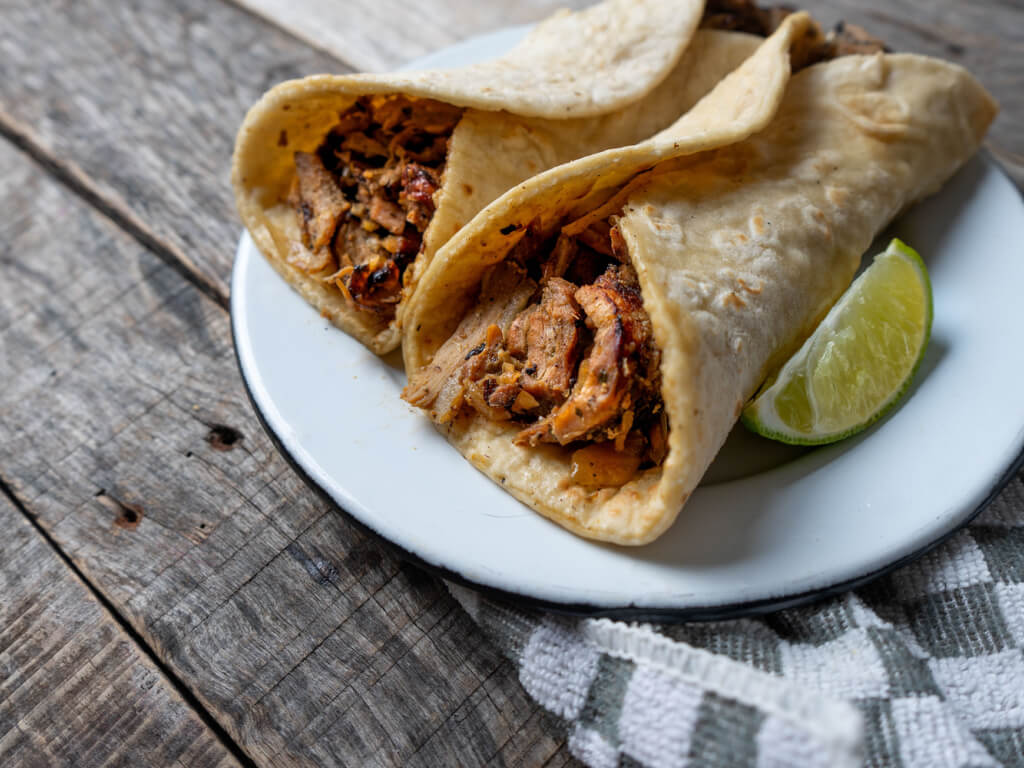
I was surprised to learn that tacos arabes originated in Puebla. I knew that tacos al pastor, also with Middle Eastern roots, were invented in Mexico City so assumed this was the birthplace of all fusion Lebanese-Mexican tacos.
While tacos al pastor are also pork meat roasted on a trompo (shwarma), they’re usually served in regular corn tacos with the addition of pineapple, cilantro, and onion. The difference with tacos arabes is that they’re served in tasty pita-style bread.
The history of tacos arabes dates back to the end of WWI when those seeking new opportunities after the demise of the Ottoman Empire arrived in the Americas.
Another difference between al pastor and arabe tacos? The meat on the trompos of Mexico City is red due to the annatto (seeds from the achiote tree) used, while tacos arabe meat is a plainer brown hue.
Where to eat tacos arabes in Puebla? The restaurant, Taquería La Oriental, is THE place to try this dish from Puebla with decades of history. The most central branch is just a couple of blocks from the Zocalo.
Molotes
Molotes are another traditional food from Puebla, not to be confused with mollettes (open sandwiches with beans and cheese popular around Mexico). These tasty snacks from Puebla could be compared to empanadas: fried masa dough filled with ingredients such as meat, cheese, potatoes, or vegetables.
Molotes are more of a snack than a main meal, found on the menu of many a Puebla restaurant. They’re cheap and cheerful, if not especially healthy!
Memelas
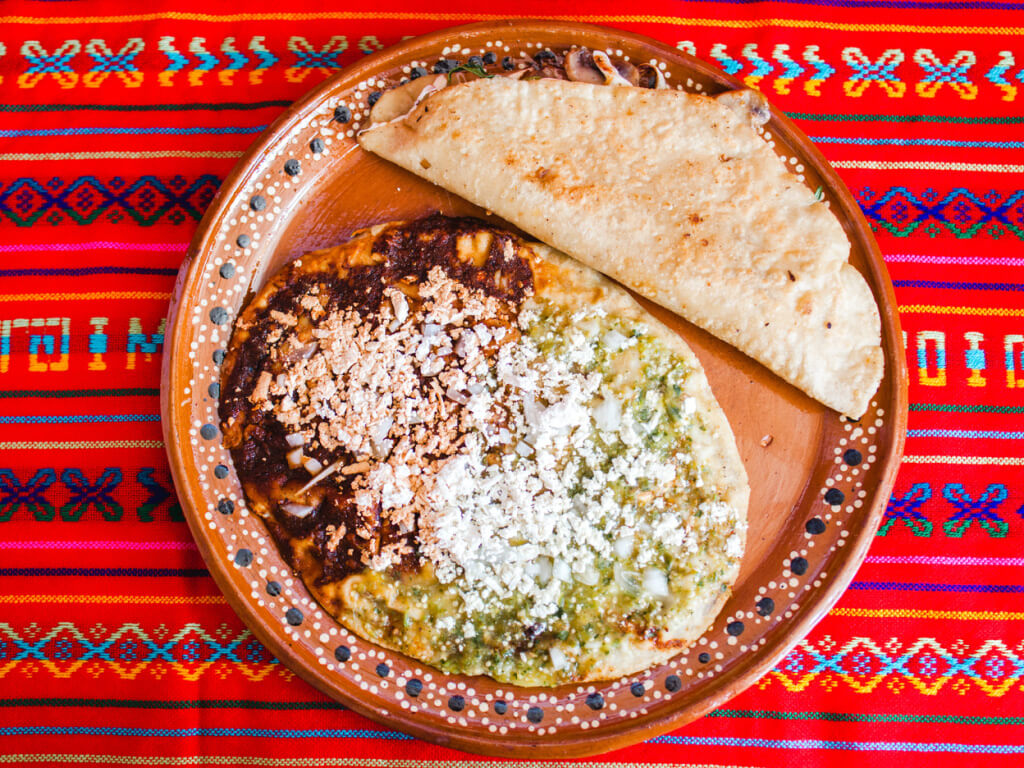
This is another food eaten in Puebla AND Oaxaca. These two cities are such foodie rivals!
Memelas are a simple dish using the foodie staples of corn masa, beans, and cheese. The base is slightly thicker than your average tortilla and usually spread with lard (vegetarians take note!) and other toppings.
This is another Puebla food eaten as a Mexican antojito (snack). Find it throughout the state of Puebla, as well as Guererro and Oaxaca. One of the best things to do in Oaxaca City is find the Netflix Street Food lady serving some of the best memelas in Central de Abastos market.
Mixiote
Finally, this delicious Mexican dish pronounced meesh-EEOH-teh isn’t from Puebla as such, but it’s certainly a dish enjoyed here. Even our tour guide on the Estacion Mexico free walking tour of Puebla who was a FOUNTAIN of knowledge felt the need to mention it.
For a mixiote, lamb meat is wrapped in the skin of the agave plant and steamed until the meat is practically falling apart. Alongside its own rich flavor is the addition of cumin, garlic, chili, and lime. It makes for a change from corn masa, at least!
Taquería y Mixiotes Barradas is the most famous place to try it, although I’ve also heard good things about the serving at Fonda de Santa Clara restaurant.
Puebla candies
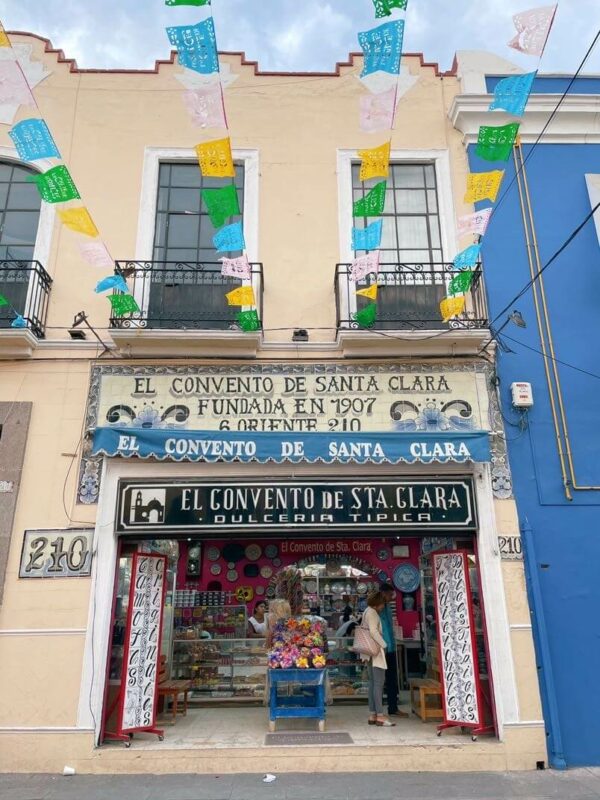
If you’re interested in the topic of the best food in Puebla, Mexico, I’m sure you’ve already heard of Calle de Dulces AKA Sweet Street! This alone is a reason for foodies to visit Puebla.
Running along Avenida 6 Oriente are more than 40 traditional candy stores dating back as far as the 1850s. Browse delicacies from cookies to wafers and caramelized peaches and sweet potatoes (nothing escapes crystallization!).
Many of the recipes were perfected in monasteries during Spanish rule when sugarcane was introduced. But sweets were made in Puebla long before this, using ingredients grown in the fertile volcano basin like fruit and pumpkin seeds.
Many of the stores offer free samples, a great way to decide what to buy! Alternatively, get a mixed box with lots of different sugary treats.
Here’s what to eat in Puebla for those with a sweet tooth…
Tortitas de Santa Clara
Santa Clara cookies are one of the most common treats to find in the dulcerias. They’re made of wheat flour, topped with a sweet layer of pepita (pumpkin seed) combined, of course, with generous amounts of milk and sugar. What else?
Borrachitos
Literally meaning ‘little drunkards’, these colorful jelly candies are flavored with fruits like strawberry, lemon, and orange, and covered in sugar sprinkles. As the name suggests, they have a touch of alcohol such as whisky or tequila.
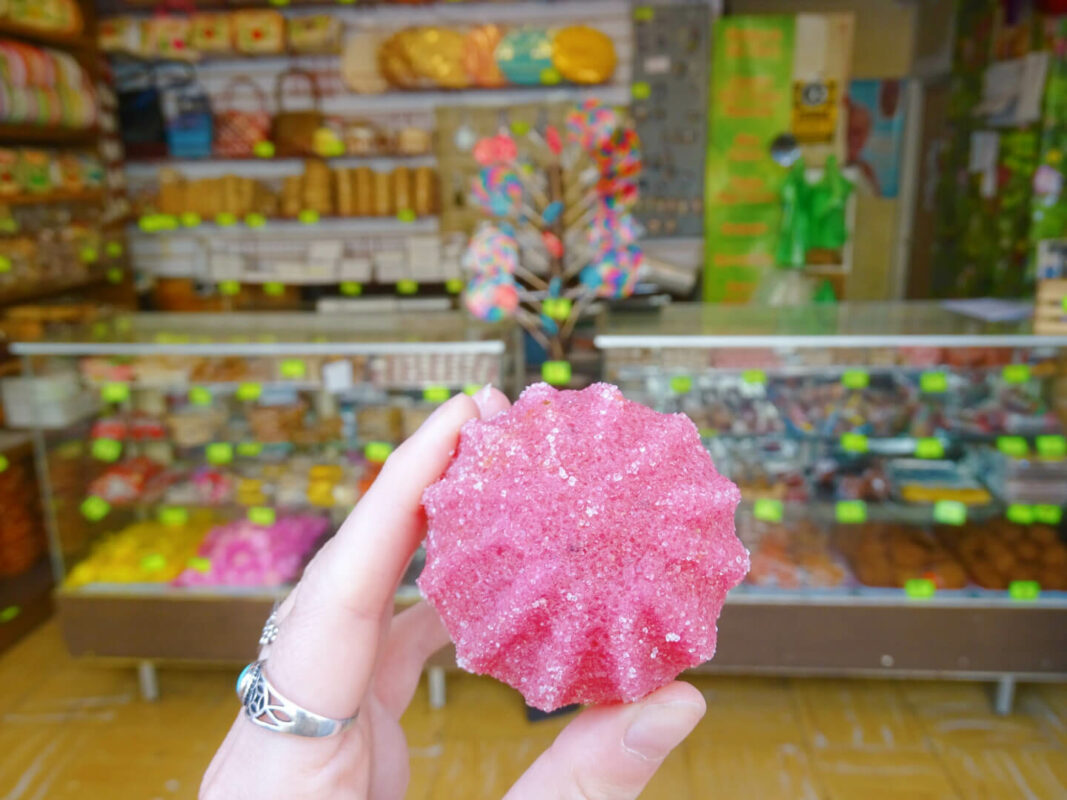
Dulces de Camote
Anyone who’s heard the piercing whistle of the camote vendors roaming the streets of Mexico City will understand Mexico’s penchant for a sweet potato.
These sweets are so popular in Puebla that no one will think you mean an actual sweet potato. Camotes de Puebla are dessert bars wrapped in paper and flavored with sweet ingredients like fruit, coconut, and vanilla. You don’t need to search far and wide; they’re served in every shop along Calle de Dulces!
Gallitos de Pepita
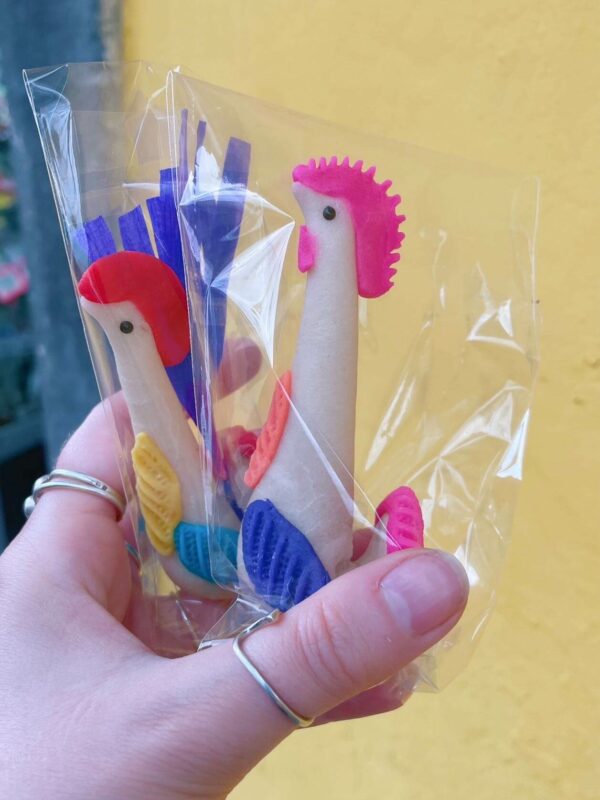
Meaning ‘pumpkin seed roosters’, these Puebla candies are shaped like little chickens. They come in different colors and only cost around 15 pesos per piece. They’re almost too pretty to eat!
Polvorones Sevillanos
Polvoron Sevillanos are, as the name suggests, not originally from Puebla. These soft, powdery cookies flavored with nuts such as almonds were born in Seville and traditionally served around Christmas. Now, they’re a popular food to try in Puebla for anyone with a sweet tooth.
Mueganos
Eaten in Puebla and Tlaxcala, these beige delicacies may not look as bright and colorful as some of the Pueblan desserts, but I can assure you they’re just as tasty. Puffy wheat flour cubes are fried and soaked in a sweet syrup made from brown sugar and cinnamon.
Mueganos are a popular Puebla food also found in stores on Calle de Dulces. Our walking tour guide told us that because butter is used in the recipe, they’re best kept in the fridge.
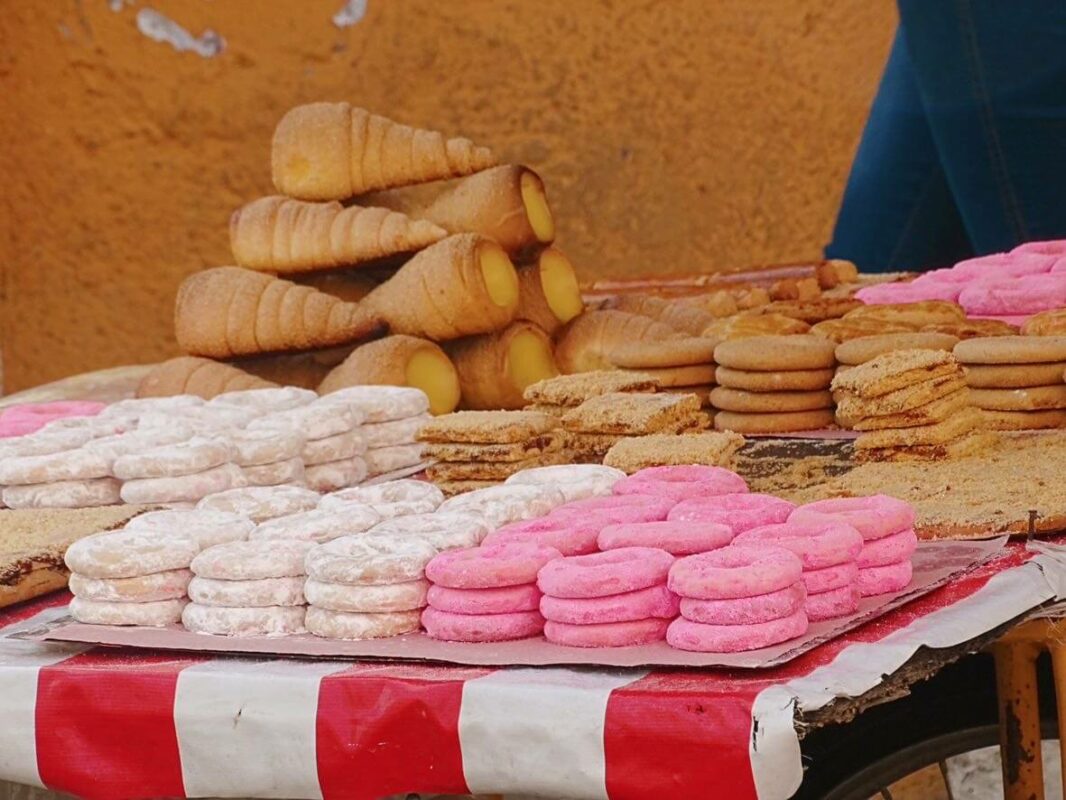
Alegria
Alegria (meaning ‘joy’) is a popular Mexican candy, variations of which can be found around the country. Typically, amaranth seeds are stuck together with honey and sugar. This delicacy is thought to originate from Puebla, and huauzontle (the local name for amaranth) was used as a ceremonial offering in prehispanic ceremonies.
Amaranth is a known superfood so this could be considered a healthy food from Puebla, although I’m not sure about all the sugar!
Galletas de Maiz
Sweet cookies made from cornmeal are a final popular Puebla snack found along Calle de Dulce… If you have any space left in your stomach which I somewhat doubt!
Puebla drinks
The topic of Poblano cuisine wouldn’t be complete without some regional beverages, especially since one in particular is famous among Poblano people and involves a local hero who lost his life. Curious? I’ll fill you in…
Here are the best drinks to wash down the delicious food in Puebla…
Pasita (raisin shots)
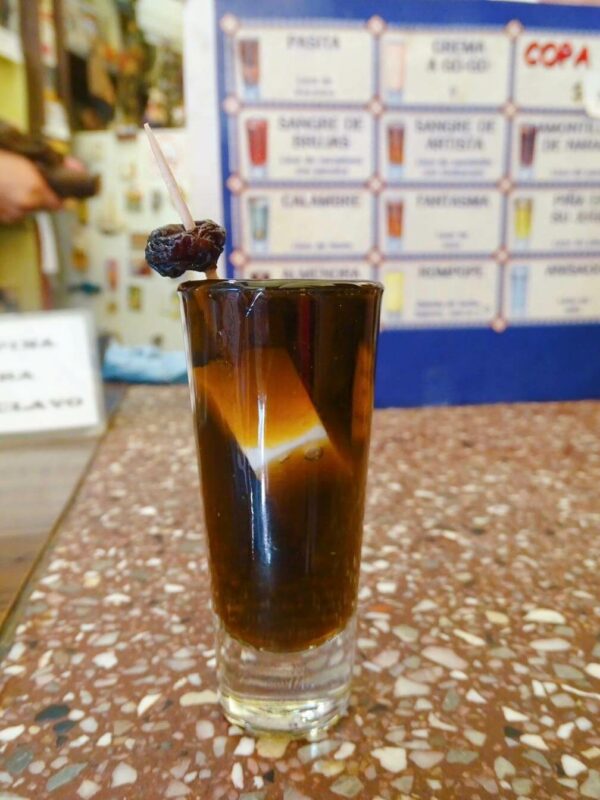
If you only visit one bar in Puebla, make sure it’s La Pasita in the colorful Los Sapos neighborhood. If you’re curious about the photo above, yes that IS cheese in a shot glass. I was apprehensive about trying this Puebla delicacy but I’m happy to say it was surprisingly tasty.
Although the raisin shot is the namesake drink at this 100-year-old bar, there are several others to try if you’re not feeling the cheesy-raisin-alcohol combo. The pineapple and walnut shot was delish, or you can try the china poblano one with three colored layers to represent the traditional style of Poblano dress.
A local legend references a man who drank 100 shots at La Pasita and DIED on the way out. Yikes! At least he went doing what he loved, AND there’s a statue dedicated to him on the bar. I guess there are worse ways to go.
Ancho Reyes
Could any drink be more ‘Mexican’ than chili liqueur? Named after ancho chilis, a type of dried pepper originating in Puebla, this popular beverage is used in cocktails around the world. However, the best place to try it is, of course, Puebla where it was invented in the 1920s and is still produced to this day.
Originally, there was just the red chili version but now, like the best Mexican condiments, there’s a verde version, too.
I had a delicious cocktail with mezcal, Ancho Reyes, and hibiscus at Miel de Agave, a fantastic mezcal bar in downtown Puebla. Don’t miss this place if you love mezcal!
Yolixpa
This herbal elixir with centuries of history is another culinary delicacy to try in Puebla translating as ‘heart medicine’ in Náhuatl.
Served since prehispanic times, Yolixpa is known for its 20+ herbal ingredients such as mint, sage, and lemon. Since the arrival of sugarcane with Spanish settlers, it’s been made by distilling sugarcane and adding honey for sweetness.
Most of the production happens in the Pueblan town of Cuetzalan, around 3 hours by car from Puebla. Luckily, it’s widely available in the city for you to try.
Rompope
Rompope is best described as eggnog. Milk, eggs, vanilla, and rum or brandy all enrich the super-sweet recipe. It’s so thick that it’s more commonly used in sweet dishes from Puebla than drinks.
Although eggnog comes from Spain, this is the Mexican version allegedly invented in the 17th century at Convent Santa Clara: the story behind most of the typical Puebla foods!
Carmen Sodas
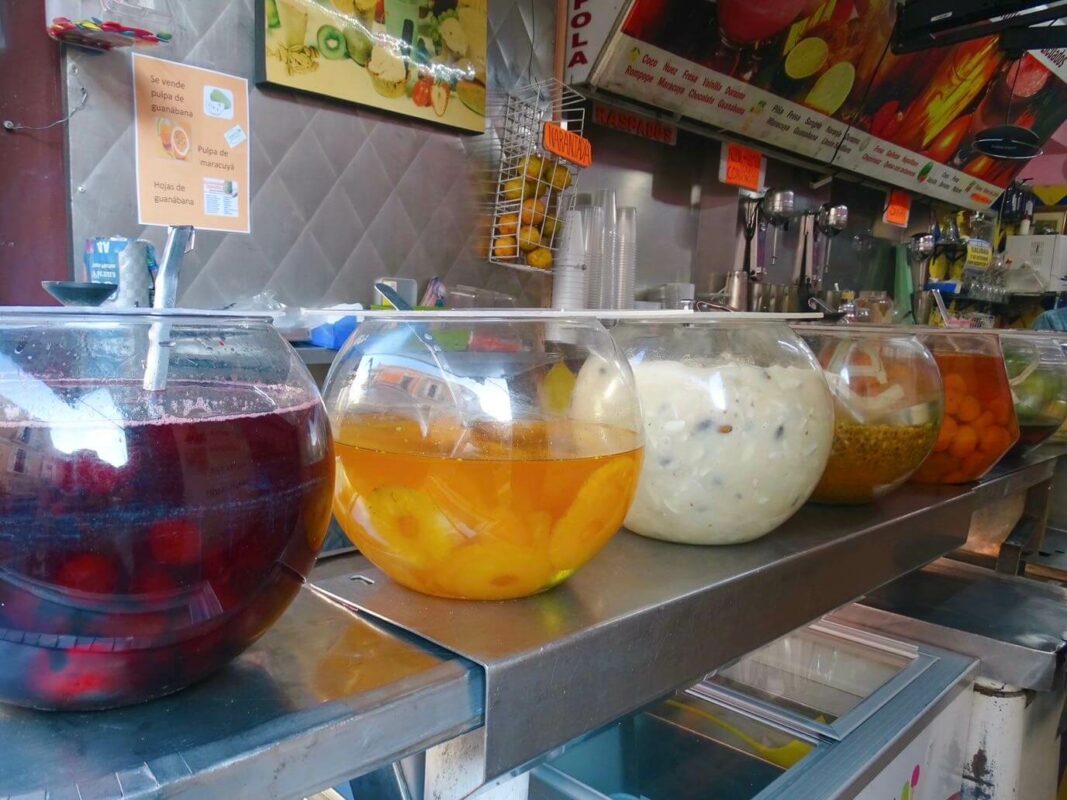
Another local institution that’s been open for more than 50 years is Carmen Sodas located near Calle de Dulce and the Revolution Museum. Run by a friendly elderly gentleman, this is a great place to cool down on a hot day over a juice, milkshake, or soda.
The best drink to order is one of the fruit sodas, displayed on the bar. Spoonfuls of thick, pulpy peach, guava, and passionfruit juice are dolloped into a cup and topped with bubbly soda water. You’ll get a straw and a spoon to eat the fresh fruit with. Divine, and only 30 pesos!
Sidra de Manzana de Zacatlan
There’s a small town in Puebla called Zacatlán de las Manzanas which translates as Zacatlán of the Apples. No prizes for guessing what fruit they famously produce!
As well as providing one of the ingredients for chili en nogada, they hold an annual apple festival and brew their own apple wine and cider. If you get the chance to try it in Puebla, do!
Puebla food tours & experiences
To try these dishes from Puebla, learn from a local, and potentially make some new friends, try a tour with GetYourGuide or Viator. My suggestions would be:
- Puebla food tour (small group) – try cemitas, tacos arabes, pasita raisin shots, and more.
- Foodie cycling tour – see Puebla on two wheels while trying local dishes.
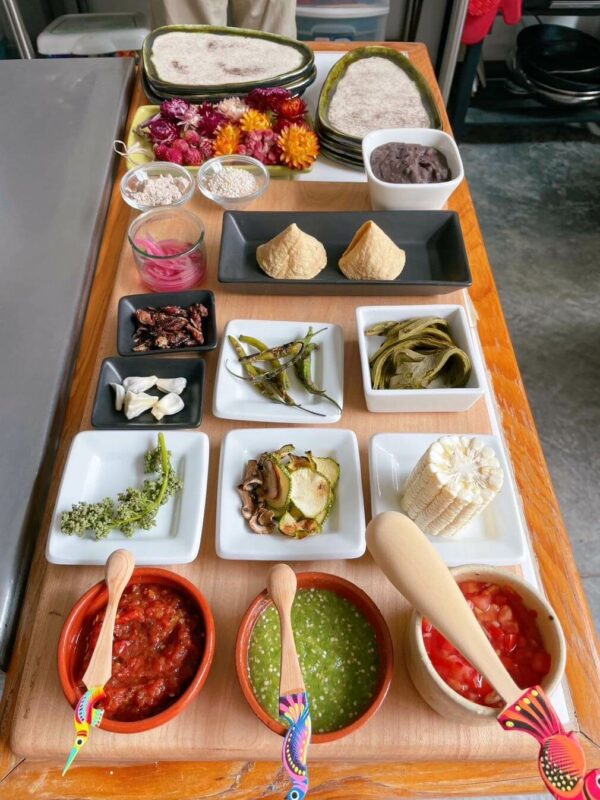

If you’re heading over to Cholula in Puebla state (just a 30-minute drive away costing 120 pesos in an Uber), I have a fantastic foodie experience to recommend. This prehispanic tour led by an architect and a professional chef is a great way to learn about the famous Cholula Pyramid (built by the Toltec people) finishing with a 7-course tasting menu.
You won’t try the modern Puebla dishes but you WILL try delicacies eaten here for centuries including tamales, tacos, and tlacoyos washed down with pulque (a typical Mexican drink made from fermented maguey plant sap, usually flavored with fruit), AND get a chance to help prepare the food in a mini cooking demo. I had such a good time!
Final thoughts on Puebla food
This list just includes the regional delicacies from Puebla but that’s not to say you shouldn’t eat other things, too! There are lots of Mexican dishes that you can find all over the country including in Puebla. These include:
- Chilaquiles – delicious fried tortilla chips topped with salsa, crema, onion, cheese, and meat or a fried egg
- Sopa de Azteca – a moreish soup featuring tortilla chips, cheese, and avocado
- Churros – there’s an amazing churreria in town called Puebla La Churreria!
- Tamales – corn dough served in a husk and stuffed with sweet or savory ingredients
- SO much more! Mexican cuisine is endless.
Thanks for reading!
I hope you have a better idea of what to eat in Puebla, Mexico. It’s such a great city for foodies (and everyone else). I can’t wait to return for round 3!
More Mexico restaurant guides:
- 28 best restaurants in San Cristobal de las Casas
- Restaurants in Todos Santo, Baja
- Where to eat in La Paz, Baja
- Best restaurants in Puerto Vallarta
Read my Mexico City posts:
- Area guide to Roma, CDMX
- Area guide to Juarez, CDMX
- The best breakfast in Mexico City
- Vegan restaurants in Mexico City
- The top cocktail bars in Mexico City
